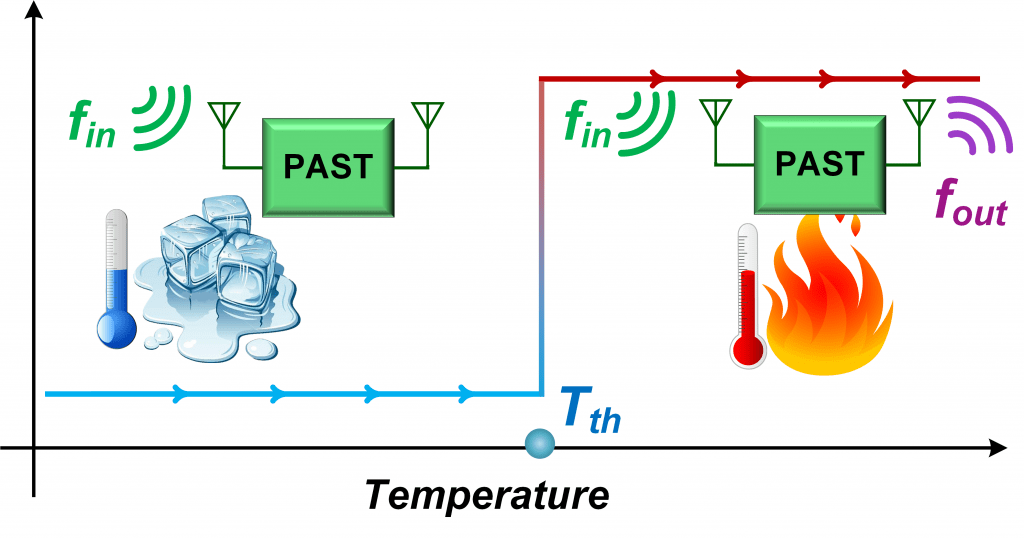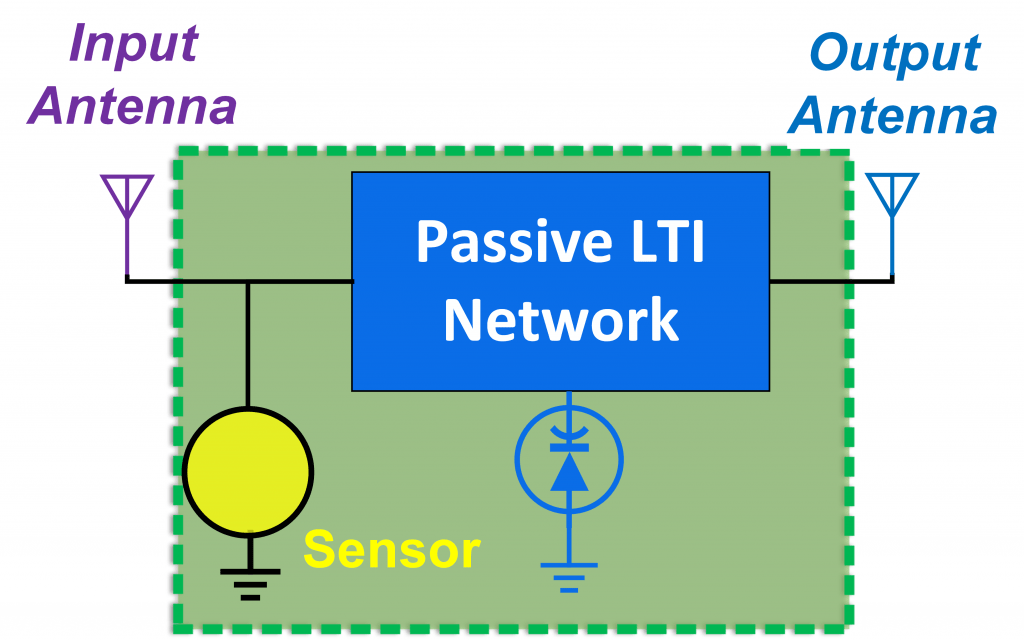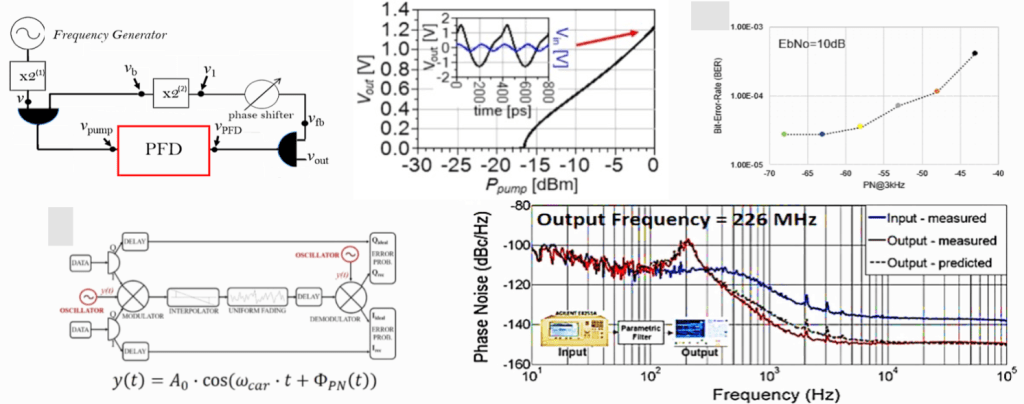What we do
Our goal is to explore unveiled fundamental physics, in micro and nano devices, to surpass the performance limitations of currently available communication and sensing systems.
Subharmonic Tags for Passive Remote Sensing
While the Internet-of-Things has already fueled a plethora of different possibilities, we are still in need of means to mitigate the inefficiencies of the cold chain generating every year massive food and drug waste, even causing serious illnesses. This is caused by the lack of remote sensing technologies suitable for a widespread deployment able to timely mark any cooled items exposed to inadequate temperatures. This work introduces a class of printable, battery-less, and chip-less passive tags, namely, the Parametric Alarm Sensor Tags (PASTs), allowing detection of any violations in the storage temperature of refrigerated items with extraordinary reading ranges. In order to do so, PASTs leverage a three-way sensing scheme and nonlinear dynamics never explored in any tag technologies to trigger the passive generation of a radio frequency signal only when the temperature exceeds a remotely configurable threshold (Tth). Furthermore, PASTs exhibit a dynamically enabled temperature-controlled hysteresis loop. As a result, the signal generated at the occurrence of a temperature violation remains active even if the temperature returns within a tolerable range. This allows us to flag any items previously or currently exposed to inadequate temperatures, allowing their prompt identification. We report a 870 MHz PAST and show that, thanks to its unique characteristics, it is finally possible to identify any items along the cold chain whose temperature has exceeded a remotely configurable Tth value as low as −47 °C, even if operating in uncontrolled electromagnetic environments and up to 46 m away from the corresponding PAST outside a line-of-sight.


RF Acoustic Components for Integrated Radio Front-Ends
Bulk and Surface Acoustic Wave resonant devices are key components in the radio-frequency multiplexers that populate 1-to-5G radios. These components leverage the excitation of acoustic waves, in piezoelectric plates, to attain on-chip resonant devices with superior quality factors (Qs), when compared to on-chip tanks using lumped inductors and capacitors. So, when properly combined, these resonant devices permit to form the on-chip filters that currently populate the passive stages of billions of wireless commercial systems across the globe. As we move fast towards wireless platforms able to exchange massive volumes of information to accommodate the growing needs of emerging applications, it is necessary to find new resonant acoustic technologies that can surpass the performance limits of the available counterparts. To do so, in MicronRF, we engineer piezoelectric acoustic devices with unique dispersion features. In particular, we look for enabling technologies exhibiting improved excitation efficiency and a larger immunity to the sources of acoustic dissipation that affect the performance of available RF micro-acoustic piezoelectric devices.

Acoustic-based CMOS-Compatible Interference Suppressors for Low-Power Radios
The increasing amount of service bands and the exponentially growing number of wireless devices, interfering with each other, challenge the sharing of the available spectrum as well as the power consumption exhibited by radio-frequency (RF) front-ends. Congestion in electromagnetic environments threatens and limits the integrity and the capacity of data exchanged between low-power wireless nodes (WNs). This is due to the compressed and saturated response exhibited by their RF receivers when exposed to co-site or jamming interference. Such performance degradation becomes more dramatic in WNs operating within the internet-of-things (IoT). In fact, these devices generally exhibit a limited dynamic range in favor of a lower power consumption and, consequently, a longer life-time. In MicronRF, we search for enabling acoustic-based CMOS-compatible nonlinear technologies that can discriminate and instinctually suppress any intolerably high interference signal. These technologies will enable radios exhibiting longer battery lifetimes, while ensuring low bit-error-rates even when operating in highly dense electromagnetic scenarios.

Open-loop Phase Noise Suppression through SHF Parametric Filters
The most important requirements for low-noise frequency generation are rooted in the needs to increase the amount of information that can be exchanged by communicating wireless nodes and to augment the detection sensitivity achieved by current resonant sensing platforms. However, the growing demand for low-power consumption of untethered and miniaturized portable electronics limits the capabilities of existing frequency generators to achieve the required frequency stability to enable larger data-rates in wireless networks, and to increase the limit-of-detection (LOD) in resonant platforms. In MicronRF, we are developing a new class of integrated low-power stabilization circuits, referred to as parametric filters. These circuits exploit the complex dynamics of parametrically driven systems to achieve the unique functionality of a low-pass filter for the phase-noise affecting their input signal. By enabling more stable frequency sources, the proposed parametric filter will allow to reduce the power consumed by wireless battery-operated nodes and to surpass the limits in resolution exhibited by available resonant sensors, thus leading to unprecedented detection capabilities.

AlScN based RF micro components for RF MEMS performance boosting and novel applications
The performances of MEMS resonators for RF applications deeply rely on the properties of the piezoelectric material adopted, which governs the ability to cyclically convert energy from the mechanical to the electrical domain. It has been recently demonstrated that Scandium doping of Aluminum Nitride (AlN) thin films increases the piezoelectric coefficients, therefore enabling larger electromechanical coupling than the one achievable with pure AlN. Moreover, the introduction of Scandium adds a ferroelectric property to the piezoelectric material, adding a degree of freedom for innovative RF applications. The non-linear dependence of physical parameters as the dielectric constant with respect to an applied electric field leads to a significant increase of the density of capacity per unit of area. This results in a smaller footprint and easy of fabrication for the next generation of MEMS resonators operating at Ultra High frequencies. An ambitious idea on which we put our efforts, is the monolithically integration of varactors and other nonlinear components with high performance MEMS resonators to enable unprecedent system configurability without the need of off-chip interconnects. Thanks to our expertise on MEMS engineering and in-house capability of sputtering AlScN thin film with different doping concentrations, in MicronRF we investigate the state-of-the-art of the next generation of MEMS resonators and novel applications in tunable circuits and multi-spectral sensors.

Massive Scale Computing and Optimization through On-chip ParameTric Ising MAchines (OPTIMA)
As Moore’s law continues to slow down, conventional von-Neumann computer architecture will reach its limit for the complexity of combinatorial optimization (CO) problems that can be solved within a reasonable frame of time. To continue to advance the degree of problems that can be solved quickly, new types of quantum-inspired computing paradigms have been proposed, namely the Ising Machine, based off the Ising Model. The model was initially used to describe ferromagnetic materials through a set of discrete variables representing different polarizations of the magnetic dipole moments in the material. These variables are either in the “spin-up” or “spin-down” state and can be arranged in a graphical structure as nodes with edges to interact with each other as constituents in a larger system. Many challenging CO problems can be mapped to an Ising Model by creating connections with different weighting between nodes and allowing the system to converge to its ground state where the least amount of energy is consumed across the entire structure. The ground state configuration of “spin-up” and “spin-down” corresponds to the best solution for many types of CO, enabling significantly reduced computation time. Using electro-acousto-parametric-oscillators (EAPO) comprised of parametric-frequency-dividers and AlScN devices, the Ising Model can be actualized into On-chip ParameTric Ising MAchine (OPTIMA) offering much better performance in terms of miniaturization, on-chip integration, usability, and manufacturability than other Ising Machine mechanisms due to the high-Q and fully passive nature of the oscillators.
